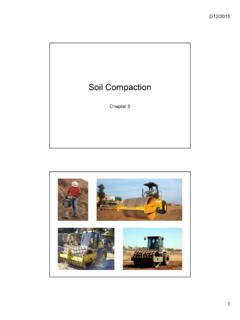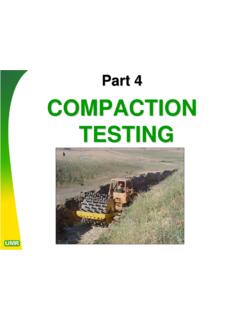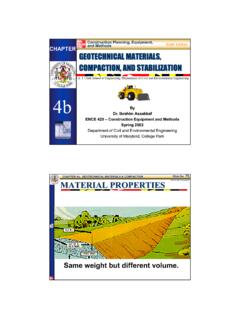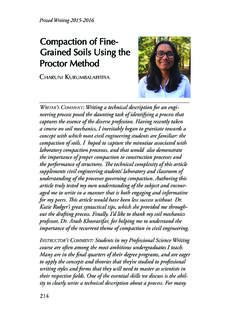Transcription of Moisture-Density Relationships by Use of the Proctor Test
1 2007-2012 Bret N. Lingwall and Evert C. Lawton Page 1 of 7 Moisture-Density Relationships by Use of the Proctor Test Geotechnical Engineering Laboratory 4 ** Warning this lab takes longer than most of the other labs ** 1. General Notes All pans must be cleaned and returned dry to the staging area after completion of all tests . All stations, benches, and tables must be cleaned before group leaves the laboratory. DO NOT share data with other groups or compare data. DO NOT fudge your data to make results better . If there are problems with the data or results, discuss what went wrong and why in the report. If you are not sure why, make an educated guess. This experiment requires considerable physical effort and is messy. Be prepared to work and get dirty. 2. Lab Procedures Enter names onto data sheet (attached). Preparatory work Find the pan, dry soil, Proctor mold, Proctor hammer, and spoon on the table. Measure the dimensions (inner diameter and height) of the mold without the collar.
2 Calculate the volume of the mold in units of ft3 from these dimensions. Lightly spray the recessed portion of the base plate with silicone spray or vegetable spray to lubricate it. Use a paper towel to spread the lubricant over the entire surface and then wipe off all excess lubricant using the same paper towel and another one if necessary. Make sure that you remove as much lubricant as possible. Moisture-Density Relationships by Use of the Proctor Test 2007-2012 Bret N. Lingwall and Evert C. Lawton Page 2 of 7 Lubricate the inner surfaces of the mold and collar using the procedure described in step above. Attach the mold (without the collar) to the base plate. Weigh the base plate plus mold and record this weight on the data sheet under the heading Trial 1. Your soil sample has been air dried. You can assume that its moisture content is about 1% unless otherwise directed by the TA. Weigh the empty pan and record its weight.
3 Carefully place the air-dried soil into the pan and record the weight of the pan plus dry soil. Decide the first moisture content to be attempted. It is advisable to get a recommendation from the TA. Use phase relations to calculate how much water needs to be added to the air-dried soil to bring it up to the initial moisture content for the test. Weigh a clean, empty moisture tin and record the weight. You will later place a small amount of soil after compaction into this tin to obtain the compaction water content. Add the water needed to bring the soil to the first moisture content. Mix the soil well in the pan with the spoon. First Trial compact the soil in five lifts Assemble the mold with the collar attached. Place the assembled mold on the floor. Add enough soil to the mold to bring it up to about the mark of the mold. Pound the soil with the Proctor hammer 25 times for each layer following the pattern shown in Fig.
4 1 (except as noted below). The TA will demonstrate the proper procedure. For each blow, the bottom of the guide sleeve should be at the surface of the soil to ensure a proper height of drop, which is 12 in. for a standard hammer and 18 in. for a modified hammer. Take care to avoid lifting the guide sleeve when raising the hammer. Hold the guide sleeve steady and within 5 of vertical. Apply the blows at a uniform rate of about 25 blows/min and in such a manner as to provide complete, uniform coverage of the surface of the specimen. Make sure you let go of the handle and allow the hammer to fall freely, rather than pushing down on the handle. (Note: Uneven surfaces can occur when compacting some soils at Moisture-Density Relationships by Use of the Proctor Test 2007-2012 Bret N. Lingwall and Evert C. Lawton Page 3 of 7 water contents above optimum. If this happens, adjust the pattern to keep the entire surface approximately even. That is, use extra blows on the higher portions of the surface to compact them to about the same height as the other portions of the surface.)
5 Add soil up to about the mark. Pound again 25 times. Add soil up to about the 4/5 mark. Pound again 25 times. Add soil up into the collar. After this last round of pounding, the entire level of the soil should be slightly (< in.) above the top of the mold. Pound again but stop after 10 blows to see if you need to add soil. Then pound again 15 more times for a total of 25 for this lift. Place the mold on the table and remove the collar. Take the scraping bar and carefully screed the soil in small sections so that it is flush with the top of the mold. Wipe away all debris. Fill any holes in the surface with unused or trimmed soil from the specimen, press in with your fingers, and again scrape across the top of the mold using the bar and wipe away all debris from the mold and the base plate. Weigh the soil and the mold minus the collar. Record this weight. Remove the sample from the mold using an extruder designed for this purpose.
6 Prepare a moisture sample (about 150 g) from the specimen after removal from the mold. Obtain about 50 g each from the top, middle, and bottom portions of the compacted specimen to ensure that the water content sample is representative of the entire specimen. Place the moisture sample into the oven to determine water content. You have completed one trial. Carefully clean the mold, collar, and base plate to remove any soil or other debris. Lubricate the base plate, mold, and collar using the same procedure as before (see steps and ). Weigh the base plate and mold and record the value on the data sheet. Add an appropriate amount of water to the soil in the pan to bring it to the next water content needed. Increase the water content about 2% to 3% each time. The TA will tell you the appropriate increment of water content to use for your soil. Moisture-Density Relationships by Use of the Proctor Test 2007-2012 Bret N. Lingwall and Evert C.
7 Lawton Page 4 of 7 Repeat the process until the weight of mold plus compacted soil are about the same for the last two water content increments. Do the test at a minimum of 5 water contents. This means the entire process will be performed at least 5 times and possibly more! Place all your moisture samples in the oven for 24 hours. Weigh upon removal. DO NOT THROW AWAY THE OVEN-DRIED SAMPLES!!!!! Place the pan with the excess wet soil in the oven. Dry for 24 hours. Using appropriate gloves, remove the pan from the oven, allow it to cool, and place on the table for subsequent sessions to use. After taking final moisture readings, put all dried soil into the pan with the rest of the dried soil. Return all equipment neatly to the location from which they were obtained. The TA will not clean up for you. Not cleaning will result in a reduction of grade. Calculations Calculate the water content for each trial. Calculate the mass of solids for each trial.
8 Calculate the dry unit weight of each trial in units of pcf. Calculate the total unit weight of each trial in units of pcf. Construct a Moisture-Density curve for your soil similar to that shown in Fig. in the textbook (Holtz, Kovacs, and Sheahan 2011). Include lines of constant saturation lines for specific gravities of and Determine the maximum dry unit weight, dmax, for your soil from the Moisture-Density curve. Determine the optimum water content, wopt, for your soil from the Moisture-Density curve. Construct a complete phase diagram for your sample at the maximum/optimum condition (wopt , d-max ). Calculate the degree of saturation for this maximum/ optimum condition and report this value as the optimum degree of saturation (Sopt ). Moisture-Density Relationships by Use of the Proctor Test 2007-2012 Bret N. Lingwall and Evert C. Lawton Page 5 of 7 Questions Discuss sources of error in the procedures or calculations.
9 Why were portions of the mold and base plate lubricated with silicone spray or vegetable spray? Visually classify your soil sample by the USCS. Why do compaction specifications require a minimum value of dry density (relative compaction )? What could be the results of the foundation soils under part of a building being compacted to 95% of the maximum dry density , while the foundation soils for the rest of the building are compacted to only 80% of the maximum dry density ? Why should compaction specifications include a moisture requirement? Why not just specify a minimum value of relative compaction without any moisture requirements? Should the moisture requirements be specified in terms of water content, degree of saturation, or both? Explain your answer. Does your calculated value of Sopt fall within the typical range of values discussed in class lecture? Did you do a standard Proctor test, a modified Proctor test, or some other level of energy?
10 Can you over-compact soils in the field? This means can you compact the soil so much that the soil loses density and/or strength? If this soil were to be used in the core of an earthen dam (low permeability), what specifications would you require with respect to minimum relative compaction , moisture condition, type of compaction roller, clod size, gravel content, and maximum as-compacted lift thickness? Provide specific values of dry density and degrees of saturation based on the results of your Moisture-Density curve. FIGURE 1. Rammer Pattern for compaction Using 4-in. ( ) Inner Diameter Mold (from ASTM D1557-07) Moisture-Density Relationships by Use of the Proctor Test 2007-2012 Bret N. Lingwall and Evert C. Lawton Page 6 of 7 Group Member Names:Test Date:Mold Dimensions =Soil Description :Trial 1 Trial 2 Trial 3 Trial 4 Trial 5 Trial 6 Estimated Water Content (%)Mass of Mold + Base Plate (g) =Mass of Mold + Base Plate + Compacted Soil (g) =Total Mass of Compacted Soil in mold (g) = moisture Tin Name (ID)Mass of Empty moisture Tin (g) =Mass of Tin + Moist moisture Sample (g) =Mass of Tin + Oven-dried moisture Sample (g) =Actual Water Content (%) =Trial 7 Trial 8 Trial 9 Trial 10 Trial 11 Trial 12 Estimated Water Content (%)Mass of Mold + Base Plate (g) =Mass of Mold + Base Plate + Compacted Soil (g) =Total Mass of Compacted Soil in mold (g) = moisture Tin Name (ID)Mass of Empty moisture Tin (g) =Mass of Tin + Moist moisture Sample (g) =Mass of Tin + Oven-dried moisture Sample (g) =Actual Water Content (%) = Proctor Test Data Sheet Moisture-Density Relationships by Use of the Proctor Test Page 7 of 7 Photographs Courtesy of Susan E.












